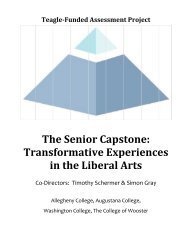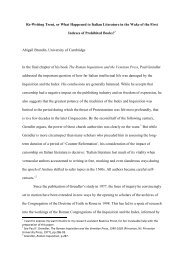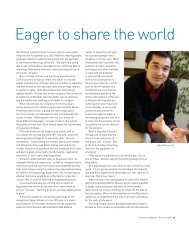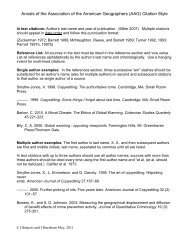Brad S. Gregory - Augustana College
Brad S. Gregory - Augustana College
Brad S. Gregory - Augustana College
Create successful ePaper yourself
Turn your PDF publications into a flip-book with our unique Google optimized e-Paper software.
church‟s teachings nor its assertions of right religious practice. 12 Nor were its doctrines<br />
changed when some territorial princes and city councils in the Holy Roman Empire<br />
began wresting away from their respective bishops jurisdictional control over many<br />
ecclesiastical affairs. 13 By contrast, to reject the church‟s truth claims was to reject its<br />
authority as the caretaker of God‟s saving truth, the means of eternal salvation<br />
legitimated with biblical reference for more than a millennium to its establishment by<br />
Jesus himself.<br />
A rejection of the Roman church‟s truth claims is precisely what happened in the<br />
Reformation, and is what distinguishes its leaders from the many late medieval reformers<br />
who sought to inspire more members of the clergy and laity to live up to the Roman<br />
church‟s teachings. The reformers who beginning in the early 1520s came to deny that<br />
the established church remained the church established by Jesus spurned many traditional<br />
teachings of medieval Christianity. Their repudiation was not based primarily on the<br />
church‟s rampant abuses, the sinfulness of many of its members, or entrenched obstacles<br />
to reform. All of these problems had been obvious to conscientious clerical reformers<br />
and other open-eyed Christians for well over a century. The real point of the<br />
Reformation was that Roman Catholicism was a perverted form of Christianity even at its<br />
best, even if all of its members had been self-consciously following all of the Roman<br />
12 On the concordats and the character of jurisdictionally “national” or “regional” churches in the fifteenth<br />
and early sixteenth centuries, see Van Engen, “The Church in the Fifteenth Century,” in Handbook, ed.<br />
<strong>Brad</strong>y et al., vol. 1, pp. 318-319; Cameron, European Reformation, pp. 53-55; Oakley, Western Church, pp.<br />
72-74; Du Boulay, Germany, pp. 187-195.<br />
13 Francis Rapp, Réformes et Réformation à Strasbourg: Eglise et Société dans de Diocèse de Strasbourg<br />
(1450-1525) (Paris: Editions Ophrys, 1974), pp. 410-419; Manfred Schulze, Fürsten und Reformation:<br />
Geistliche Reformpolitik weltlicher Fürsten vor der Reformation (Tübingen: Mohr, 1991); Ronald K.<br />
Rittgers, The Reformation of the Keys: Confession, Conscience, and Authority in Sixteenth-Century<br />
Germany (Cambridge, Mass. and London: Harvard University Press, 2004), pp. 18-21; William <strong>Brad</strong>ford<br />
Smith, Reformation and the German Territorial State: Upper Franconia, 1300-1630 (Rochester, N. Y.:<br />
University of Rochester Press, 2008), pp. 17-58. Nor did the expulsion of bishops as civic rulers betoken<br />
changes in doctrine or proper religious practice. See J. Jeffrey Tyler, Lord of the Sacred City: The<br />
Episcopus exclusus in Late Medieval and Early Modern Germany (Leiden: E. J. Brill, 1999).<br />
6
















